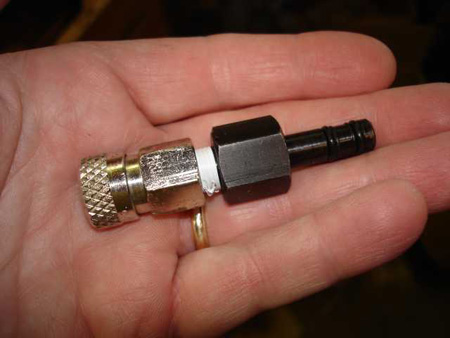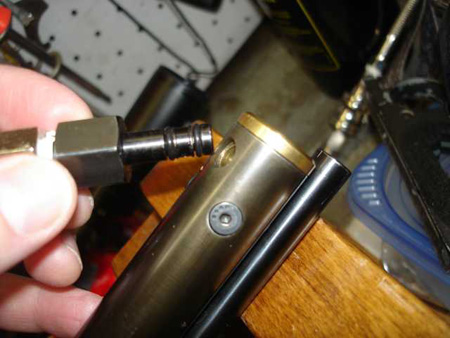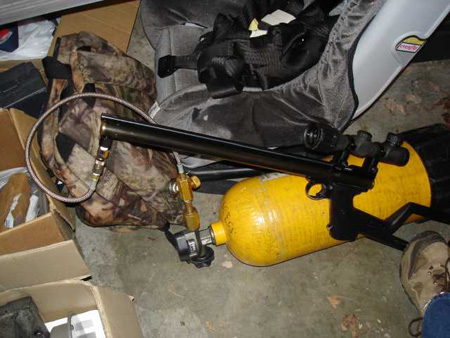Airgun Powerplants
Airgun power plants have a great deal to do with what kind of airgun you choose to buy. There are many variables that may affect your shooting habits?.temperature, distance, if you are shooting targets or hunting, plinking or competition?..a lot of different reasons for choosing the correct type of power plant for your needs.
So just how many kinds of airguns are there? Basically, there are 5 types of airgun power plants, and each one has its pros and cons. Let's take a look at the different means of propelling a pellet or BB and think about which kind would best meet your specific shooting needs. The 5 types of power plants are:
- Spring piston
- Pneumatic
- CO2 gas
- Pre-charged pneumatic (PCP)
- The traditional BB gun.
Spring-Piston
The most common type of airgun is the spring-piston type. Unlike pneumatic and CO2 pellet guns, there is no storage compartment for air or gas on a spring-piston airgun. Rather, a powerful spring is compressed upon cocking the gun, and when the trigger is released, a piston is driven forward which quickly compresses air to a high pressure, driving the pellet out of the barrel. This type of power plant is tried and tested, and has the advantage of producing the same power level shot after shot, rather than losing power like CO2 and PCP airguns do as pressure decreases. They are simple to use, and can be obtained in a variety of power levels from low-velocity plinkers to higher-powered hunting airguns delivering 30 fpe (foot pounds of energy). They are self-contained, not needing to be re-charged with air, and all you need to enjoy shooting them is the gun and some ammo. Some of the cons of spring-piston power plants are that they are sometimes harder to shoot accurately for beginners, and in the more powerful models, need a certain type of scope to withstand the vibrations that result from the recoil generated by the firing action. However, once the correct method of shooting is learned, spring-piston airguns deliver years of shooting pleasure that is hard to beat.
Pump Pneumatic
Pneumatic airguns are extremely popular, especially in America. Whereas spring-piston airguns enjoyed a following in Europe and other countries, the pump-up pneumatic gained popularity here in America. Names such as Daisy, Crosman, Sheridan, and Benjamin were household names when describing airguns here in the States. Today, many of the airguns available for the youth market can still be found bearing the Daisy and Crosman names, with Benjamin and Sheridan having combined, and subsequently been purchased by the Crosman brand. Pneumatic airguns contain a reservoir that is filled by pumping up the gun, with the pump usually being built into the gun itself. When the trigger is pulled, the reservoir is opened and the air escapes, propelling the pellet. I grew up with this kind of airgun, and enjoyed one of the obvious advantages of such a power plant. You could vary the power level of the gun simply by varying the number of pumps you used to charge the reservoir. Some of the most accurate airguns available are pump-up guns, many of them using only a single pump to provide a very consistent level of power for target shooting. There is almost no recoil, and accuracy is easier to obtain quickly than from a spring-piston airgun. The drawback to pneumatic airguns is the need to pump the gun up after each shot. If you are hunting, this means you often lose your game if you missed the first shot due to the movement caused by recharging your airgun for the next shot. It does have the side effect of teaching you the importance of making the first shot count!
CO2
Carbon-dioxide, or CO2, is usually supplied to an airgun with a reservoir via bulk filling or from a powerlet, often called a CO2 cartridge. CO2 is an excellent propellant, and allows the shooter to charge the gun and shoot many times before needing to replenish the CO2. Under pressure, CO2 is a liquid, and when placed in the reservoir of an airgun, it self-regulates and provides gas for shot after shot until all the liquid CO2 is converted into gas and used. One drawback to CO2 is its sensitivity to temperature. If the climate is cold, CO2 tends to stay in liquid form, and the power level achieved is much less. In extremely hot conditions, the pressure rises significantly, and often the pressure becomes too great, locking up the valve on the gun. When that happens, you have to cool the gun down before it can shoot again. I've actually put one of my guns in the freezer for a few minutes to regain its use on an extremely hot day! If you are a hunter, CO2 works great in warm climates, or ealier in the season in cooler climates. But once winter sets in, extended periods outside hunting are impractical.
PCP
Pre-charged pneumatics, or PCP's, use a reservoir like CO2 guns, but the propellant is high-pressure air, not CO2 gas. The pressures involved are much higher, from 1500 to3500 psi, sometimes higher. The power levels on PCP airguns usually outstrip those available from CO2 or spring-piston guns, and almost all of the modern big-bore airguns that one might use to hunt larger game such as deer or hogs rely on this power plant. The smaller calibers are almost recoil-free and offer extremely good accuracy. PCP has quickly become the propellant of choice for target and FT shooters who don't shoot in the spring-piston class. However, PCP does have its drawbacks. You need a source for air, either a special hand pump or a scuba tank or other high-pressure vessel capable of containing 3000 psi or more. And then you need a source for filling your tanks. It isn't always easy to find a source of high-pressure air, but the most common places are dive shops, fire departments, and paintball game locations. There are commercially available electric and gas-driven pumps available, but they are prohibitive in cost for the casual shooter. You are better off renting or leasing a large tank from a welding shop and having them fill it for you when you run low on air. To fill a PCP airgun, you must have the correct probe or connector that fits the gun attached to a source of air, either a tank or pump. (The probe should have come with your airgun, but if you are buying on the second-hand market, you will sometimes acquire a gun that has no probe. Contact the manufacturer to obtain the correct probe for your model of gun.) In the example below, the probe is inserted into the end of the reservoir, and the pressure valve on the tank is slowly opened to fill the gun.

Probe Adapter

Insert Probe In Tank

Connect Hose to Air Source Such as a Scuba Tank or Hand Pump
Fill the airgun slowly, no more than 100 psi per second. If you fill too fast, the reservoir will heat up from the pressurized air, which isn't especially good for the seals in your airgun. Once the desired fill pressure is achieved, close the pressure valve and bleed off the excess air in the hose by opening the bleed-off valve. This will release the excess air still trapped in the hose, allowing you to remove the probe from the gun without damaging it. Only fill your airgun to the manufacturer's suggested limit. The valve in your airgun is made to work at that optimum pressure. Air tanks come in a variety of sizes and weights. I would recommend a 4500 psi tank made of lighter-weight materials before using scuba tank. They hold more air and will give you more fills before you need to top them off again. One word of caution: High pressure air is NOT pure oxygen. Pure oxygen is flammable, and you are holding your life and the lives of those around you in low regard if you fill your PCP airgun with oxygen. There have been cases of individuals using medical supply oxygen to fill their guns. Don't be stupid!
Traditional BB guns
The ubiquitous BB gun, such as the Red Ryder from Daisy, is a gun that many of America's youth grew up with. It is a hybrid gun of sorts. It uses a catapult to start the BB on its way, and a very light spring-piston to accelerate the BB down the barrel. They work well, and are often an airgunner's first introduction to airguns. The power level is low compared to other power plants, and you most often find it on the lower end of airguns. The ammo is most often a steel BB that has a nasty habit of ricocheting more than a lead pellet, so caution should be used, especially when teaching youngsters the finer points of safe gun-handling. These are the power plants that allow us to enjoy the sport of airgunning. Choosing which one is best for you is a personal decision that can involve some trial and error?.but it is all fun! So enjoy!
By Randy Mitchell
Written Exclusively for Airgun Depot